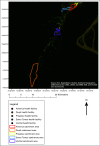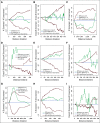Understanding Geospatial Factors Associated With Cervical Cancer Screening Uptake in Amazonian Peruvian Women
- PMID: 32755481
- PMCID: PMC7456312
- DOI: 10.1200/GO.20.00096
Understanding Geospatial Factors Associated With Cervical Cancer Screening Uptake in Amazonian Peruvian Women
Abstract
Purpose: Cervical cancer (CC) is the most common and second-most deadly cancer among Peruvian women. Access to services is strongly associated with CC screening uptake. This study investigated geospatial features contributing to utilization of screening. We used geolocated data and screening information from a Knowledge, Attitudes, and Practice (KAP) survey implemented in Iquitos, Peru in 2017.
Materials and methods: The KAP collected cross-sectional CC screening history from 619 female interviewees age 18-65 years within 5 communities of varying urbanization levels. We used spatial statistics to determine if screened households tended to cluster together or cluster around facilities offering screening in greater numbers than expected, given the underlying population density.
Results: On the basis of K-functions, screened households displayed greater clustering among each other as compared with clustering among unscreened households. Neighborhood-level factors, such as outreach, communication, or socioeconomic condition, may be functioning to generate pockets of screened households. Cross K-functions showed that screened households are generally located closer to health facilities than unscreened households. The significance of facility access is apparent and demonstrates that travel and time barriers to seeking health services must be addressed.
Conclusion: This study highlights the importance of considering geospatial features when determining factors associated with CC screening uptake. Given the observed clustering of screened households, neighborhood-level dynamics should be further studied to understand how they may be influencing screening rates. In addition, results demonstrate that accessibility issues must be carefully considered when designing an effective cancer screening program that includes screening, follow-up, and treatment.
Conflict of interest statement
Patti E. Gravitt
Anne F. Rositch
No other potential conflicts of interest were reported.
Figures


References
-
- International Agency for Research on Cancer (IARC): Stewart BW, Wild CP (eds): World Cancer Report 2014. Lyon, France, IARC Press, 2014.
-
- International Agency for Research on Cancer: GLOBOCAN 2018, Population Fact Sheets. Lyon, France. https://gco.iarc.fr/today/data/factsheets/populations/900-world-fact-she....
-
- http://globocan.iarc.fr Ferlay J, Soerjomataram I, Ervik M, et al: GLOBOCAN 2012 v1.0, Cancer Incidence and Mortality Worldwide: IARC CancerBase No. 11. Lyon, France, International Agency for Research on Cancer, 2013.
-
- https://www.gob.pe/institucion/minsa/normas-legales/191413-1013-2016-minsa Ministerio de Salud, Republica del Perú: Resolución Ministerial No. 1013-2016.

